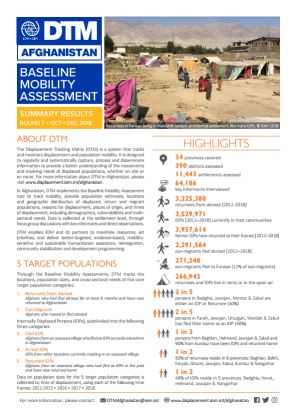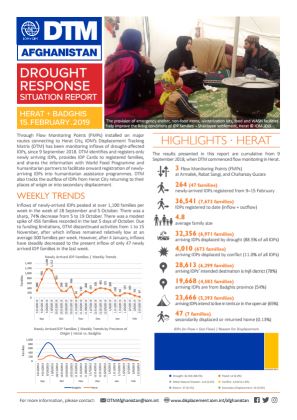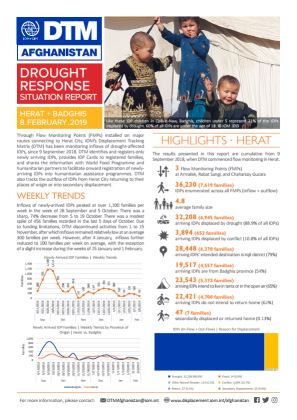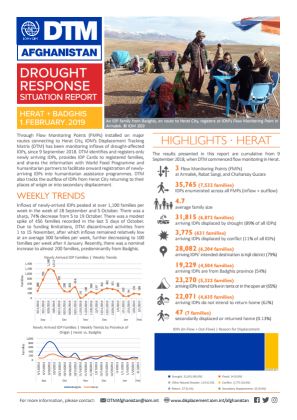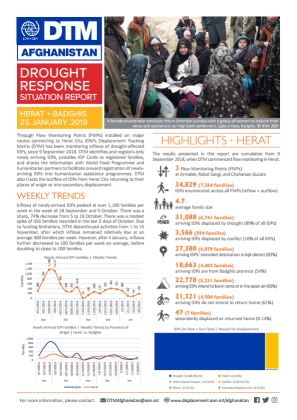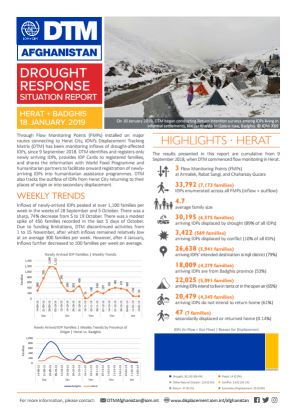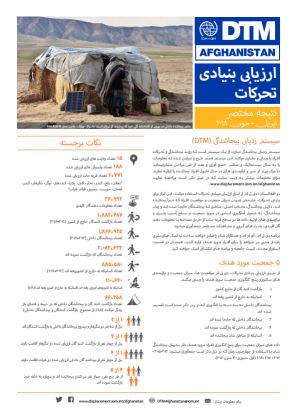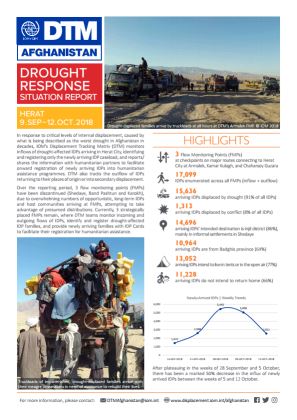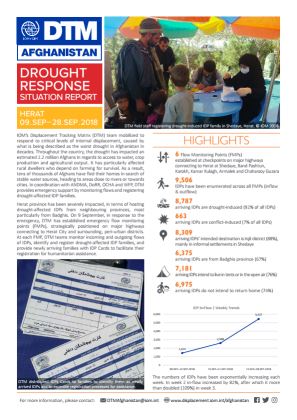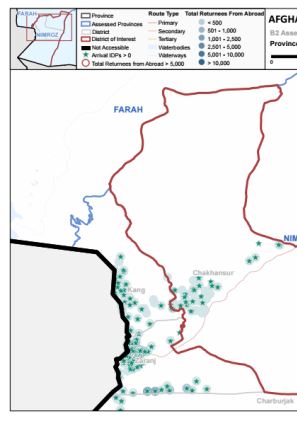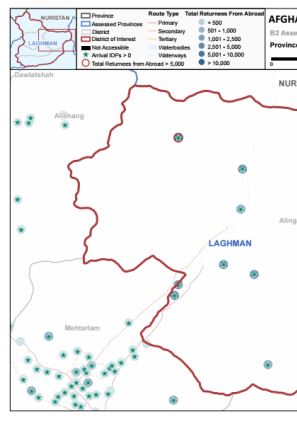-
Countries
-
Data and Analysis
-
Special Focus
-
Crisis Responses
Afghanistan
Afghanistan
Suivi des PDI
Mouvements de déplacement
4,187,000
IDMC 2023
cycle de collecte de données
À propos Afghanistan
The Displacement Tracking Matrix (DTM) is an information management system of tools and methodologies used to track and monitor displacement and population mobility. In Afghanistan, IOM activated the DTM programme in January 2017 in response to the substantial increase of Afghans returning home from neighbouring countries, as well as record levels of internal displacement. DTM in Afghanistan is designed to regularly and systematically capture, process and disseminate multi-layered information about the population sizes, locations, geographic distribution, movements, vulnerabilities, evolving multisectoral needs, and the drivers of migration of returnees, IDPs, migrants and mobile populations. DTM implements baseline mobility assessments, flow monitoring, registrations, and various migration surveys to provide an essential evidence base that enables decision-makers and humanitarian, reintegration and development partners to maximize resources and deliver efficient, better-targeted, mobility-sensitive and sustainable humanitarian; reintegration, community stabilization and development programming.
The value-added impact of DTM in Afghanistan is to inform action and results for people in need. DTM Afghanistan implements its activities at both the national and provincial levels. DTM works closely with other (IOM) programmes through referring identified populations in need of assistance at flow monitoring points to IOM’s Cross Border Return and Reintegration, Protection, Humanitarian Assistance, and Reintegration and Development (RADA) programmes. DTM Afghanistan also supports humanitarian partners and clusters, including WFP, FAO, UNHCR, IRC, DRC, NRC, and WHO, among many others, by providing emergency tracking updates in large-scale or sudden onset movements, such as emergency event tracking and drought response. Furthermore, stabilization and development actors, including IOM’s RADA programme, and the World Bank leverage DTM’s information to select priority communities and districts with higher concentrations of IDPs and returnees to receive reintegration and livelihoods assistance and improvements to core infrastructure and essential services. In support of health partners, including WHO, UNICEF, and the Humanitarian Health Cluster, DTM data informs the selection of priority, at-risk districts, border areas, communities, and health facilities in need of strengthened capacity, response, surveillance, and risk education for polio, TB, COVID-19, and other infectious diseases.
Contacter
Modher ALHAMADANI
Senior Programme Coordinator - DTM
malhamadani@iom.int
DTM AFGHANISTAN
DTMAFGHANISTAN@iom.int
Bailleurs de fonds
- Republic of Korea
- Norway
- CERF
- Canada
- Italy
- EU
- FCDO
Afghanistan — Baseline Mobility Assessment Summary Results (October—December 2018)
In Afghanistan, DTM employs the Baseline Mobility Assessment tool, designed to track mobility, determine the population sizes and locations of forcibly displaced people, reasons for displacement, places of origin, displacement locations and times of displacement, including basic demographics, as
Afghanistan — Drought Response Situation Report (15 February 2019)
Through Flow Monitoring Points (FMPs) installed on major routes connecting to Herat City, IOM’s Displacement Tracking Matrix (DTM) has been monitoring inflows of drought-affected IDPs, since 9 September 2018.
Afghanistan — Drought Response Situation Report (8 February 2019)
Through Flow Monitoring Points (FMPs) installed on major routes connecting to Herat City, IOM’s Displacement Tracking Matrix (DTM) has been monitoring inflows of drought-affected IDPs, since 9 September 2018.
Afghanistan — Drought Response Situation Report (1 February 2019)
Through Flow Monitoring Points (FMPs) installed on major routes connecting to Herat City, IOM’s Displacement Tracking Matrix (DTM) has been monitoring inflows of drought-affected IDPs, since 9 September 2018.
Afghanistan — Drought Response Situation Report (25 January 2019)
Inflows of newly-arrived IDPs peaked at over 1,100 families per week in the week of 28 September and 5 October. There was a sharp, 74% decrease from 5 to 19 October. There was a modest
Afghanistan — Drought Response Situation Report: Herat and Badghis (9 September 2018—18 January 2019)
Through Flow Monitoring Points (FMPs) installed on major routes connecting to Herat City, IOM’s Displacement Tracking Matrix (DTM) has been monitoring inflows of drought-affected IDPs, since 9 September 2018.
Afghanistan — Baseline Mobility Assessment Summary Results (April—June 2018) [Dari]
In Afghanistan, DTM employs the Baseline Mobility Assessment tool, designed to track mobility, determine the population sizes and locations of forcibly displaced people, reasons for displacement, places of origin, displacement locations and times of displacement, including basic demographic
Afghanistan — Drought Response Situation Report: Herat (9 September - 26 October 2018)
Over the reporting period, IOM maintained three strategically placed flow monitoring points (FMPs), where DTM teams monitor inflows and ouflows of IDPs, identify and register drought-affected IDP families, and provide newly arriving families with IDP Cards to facilitate their registration f
Afghanistan — Drought Response Situation Report: Herat (9 September — 12 October 2018)
Currently, 3 strategically placed FMPs remain, where DTM teams monitor incoming and outgoing flows of IDPs, identify and register drought-affected IDP families, and provide newly arriving families with IDP cards to facilitate their registration for humanitarian assistance.
Afghanistan — FMP Operational Methodology (September 2018)
The role of IOM’s Displacement Tracking Matrix (DTM) within the humanitarian drought response is to monitor inflows of IDPs arriving in Herat, identify and register only the newly arriving IDP caseload, and report/share the information with humanitarian partners to facilitate onward registration
Afghanistan — Drought Response Situation Report (September 2018)
IOM’s Displacement Tracking Matrix (DTM) team mobilized to respond to critical levels of internal displacement, caused by what is being described as the worst drought in Afghanistan in decades.
(دری) Afghanistan — Drought Response Situation Report (September 2018)
[This report is in Dari.]
Afghanistan — Map: Overview maps (June 2018)
The following document is a compilation of maps providing a country overview on the following topics and population groups: - Baseline Mobility Assessment | Settlement Level | Total Inflow (Returnees and IDPs)
Sep 26 2018
Afghanistan — Map: Overview maps (June 2018)
Afghanistan — Map: Village Population (June 2018)
The following compilation of maps provides information on the village population as of June 2018, by province.
Afghanistan — Map: Village Population (June 2018)
The following three maps present information on the number of total returnees from abroad, in Central, Eastern and Southeast Afghanistan, Northern and Northeast Afghanistan, as well as in Western and Southern Afghanistan.
Afghanistan — District Maps Baghlan (June 2018)
The following maps provide information on the number of returnees from abroad in different districts of the Baghlan Province, Afghanistan.
Sep 25 2018
Afghanistan — District Maps Baghlan (June 2018)
Afghanistan — Baseline Assessment Form (August 2018)
The following document is the baseline assessment form used for the Baseline Mobility Assessments conducted by DTM Afghanistan.
Afghanistan — Baseline Mobility Assessment Summary Results (April—June 2018)
In Afghanistan, DTM employs the Baseline Mobility Assessment tool, designed to track mobility, determine the population sizes and locations of forcibly displaced people, reasons for displacement, places of origin, displacement locations and times of displacement, including basic demographic
Afghanistan — Settlement Maps District Atlas — Takhar (March 2018)
These maps provide details on settlements in each of the 17 districts in the Afghan province of Takhar, as found during DTM's B2 assessment exercise, as of March 2018.
Afghanistan — Settlement Maps District Atlas — Nimroz (March 2018)
These maps provide details on settlements in each of the 5 districts in the Afghan province of Nimroz, as found during DTM's B2 assessment exercise, as of March 2018.
Afghanistan — Settlement Maps District Atlas — Nangarhar (March 2018)
These maps provide details on settlements in each of the 22 districts in the Afghan province of Nangarhar, as found during DTM's B2 assessment exercise, as of March 2018.
Afghanistan — Settlement Maps District Atlas — Paktya (December 2017)
These maps provide details on settlements in each of the 11 districts in the Afghan province of Paktya, as found during DTM's B2 assessment exercise, as of December 2017.
Afghanistan — Settlement Maps District Atlas — Logar (December 2017)
These maps provide details on settlements in each of the 7 districts in the Afghan province of Logar, as found during DTM's B2 assessment exercise, as of December 2017.
Afghanistan — Settlement Maps District Atlas — Laghman (March 2018)
These maps provide details on settlements in each of the 5 districts in the Afghan province of Laghman, as found during DTM's B2 assessment exercise, as of March 2018.
Pagination
Pagination
Pagination
- First page
- Previous page
- 1
- 2
- 3
- 4
- 5


